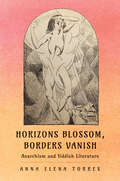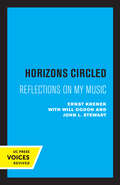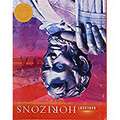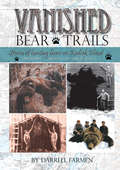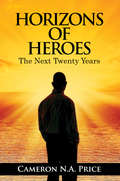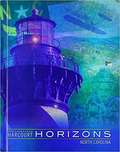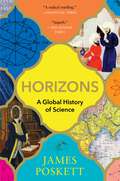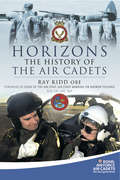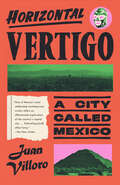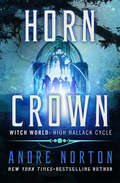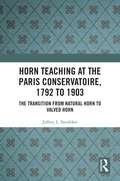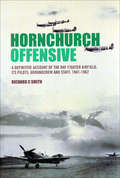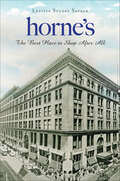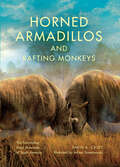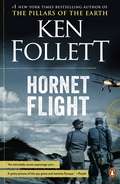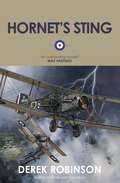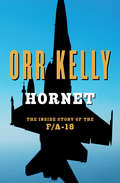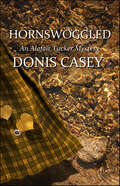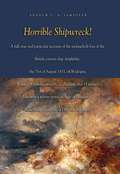- Table View
- List View
Horizons Blossom, Borders Vanish: Anarchism and Yiddish Literature
by Anna Elena TorresA bold recovery of Yiddish anarchist history and literature Spanning the last two centuries, this fascinating work combines archival research on the radical press and close readings of Yiddish poetry to offer an original literary study of the Jewish anarchist movement. The narrative unfolds through a cast of historical characters, from the well known—such as Emma Goldman—to the more obscure, including an anarchist rabbi who translated the Talmud and a feminist doctor who organized for women&’s suffrage and against national borders. Its literary scope includes the Soviet epic poemas of Peretz Markish, the journalism and modernist poetry of Anna Margolin, and the early radical prose of Malka Heifetz Tussman. Anna Elena Torres examines Yiddish anarchist aesthetics from the nineteenth-century Russian proletarian immigrant poets through the modernist avant-gardes of Warsaw, Chicago, and London to contemporary antifascist composers. The book also traces Jewish anarchist strategies for negotiating surveillance, censorship, detention, and deportation, revealing the connection between Yiddish modernism and struggles for free speech, women&’s bodily autonomy, and the transnational circulation of avant-garde literature. Rather than focusing on narratives of assimilation, Torres intervenes in earlier models of Jewish literature by centering refugee critique of the border. Jewish deportees, immigrants, and refugees opposed citizenship as the primary guarantor of human rights. Instead, they cultivated stateless imaginations, elaborated through literature.
Horizons Circled: Reflections on My Music
by Ernst KrenekThis title is part of UC Press's Voices Revived program, which commemorates University of California Press’s mission to seek out and cultivate the brightest minds and give them voice, reach, and impact. Drawing on a backlist dating to 1893, Voices Revived makes high-quality, peer-reviewed scholarship accessible once again using print-on-demand technology. This title was originally published in 1974.
Horizons United States History: Beginnings
by Robert P. Green Thomas M. Mcgowan Linda Kerrigan SalvucclUS History Textbook (Louisiana)
Horizons of Heroes 2: The Next Twenty Years
by Cameron PriceAfter returning from the Vietnam War, Cameron finds the United States has changed in ways he could not have imagined. He struggles to find his path through challenges in relationships, school, and employment. As an African American in the early 1970s, Cameron learns he must persevere a great deal more than the average person in order to achieve his goals and dreams. As one of the former highest ranking spies in the military, Cameron dares to share his view on how women know if it is “real love.” Horizons of Heroes: The Next Twenty Years is an amazing non-fiction book and an excellent read.
Horizons of Heroes: The Next Twenty Years
by Cameron PriceAfter returning from the Vietnam War, Cameron finds the United States has changed in ways he could not have imagined. He struggles to find his path through challenges in relationships, school, and employment. As an African American in the early 1970s, Cameron learns he must persevere a great deal more than the average person in order to achieve his goals and dreams. As one of the former highest ranking spies in the military, Cameron dares to share his view on how women know if it is “real love.” Horizons of Heroes: The Next Twenty Years is an amazing non-fiction book and an excellent read.
Horizons unfolding' (Bregdan Chronicles #12)
by Ginny DieHorizons Unfolding is the 12th in the best-selling Bregdan historical fiction series. Is reconstruction healing America or is it really covering for a new war? America continues the struggle to become a country for everyone. Carrie steps into a new love, but needs to leave the plantation to fulfill her dream. She is challenged when Frances makes friends that reveal a new hidden horror. And then there are the new conflicts facing Rose and Moses. Last of all Thomas and Abbey create an unexpected but beautiful miracle. A really nice read.
Horizons: North Carolina Edition
by Harcourt School Publishers StaffHarcourt Horizons North Carolina
Horizons: The Global Origins of Modern Science
by James PoskettThe history of science as it has never been told before: a tale of outsiders and unsung heroes from far beyond the Western canon that most of us are taught.When we think about the origins of modern science we usually begin in Europe. We remember the great minds of Nicolaus Copernicus, Isaac Newton, Charles Darwin, and Albert Einstein. But the history of science is not, and has never been, a uniquely European endeavor. Copernicus relied on mathematical techniques that came from Arabic and Persian texts. Newton’s laws of motion used astronomical observations made in Asia and Africa. When Darwin was writing On the Origin of Species, he consulted a sixteenth-century Chinese encyclopedia. And when Einstein studied quantum mechanics, he was inspired by the Bengali physicist, Satyendra Nath Bose.Horizons is the history of science as it has never been told before, uncovering its unsung heroes and revealing that the most important scientific breakthroughs have come from the exchange of ideas from different cultures around the world. In this ambitious, revelatory history, James Poskett recasts the history of science, uncovering the vital contributions that scientists in Africa, America, Asia, and the Pacific have made to this global story.
Horizons: The History of the Air Cadets (Royal Airforce Air Cadets:The Next Generation)
by H. R. KiddAlthough the first air cadet unit was raised in Bournmouth in 1928, the first squadrons to be formed in a privately funded national organisation were part of the Air Defence Cadet Corps in 1938. Thousands of youngsters joined and were able to learn about aircraft, aerodynamics, navigation, mechanics and other subjects not taught in schools. The organization was to become known as The Air Training Corps (ATC) and as war loomed it was considered a useful RAF recruitment tool to attract potential airmen and ground crew. Throughout the war ATC cadets supported the home defences by fire watching, as messengers and as observers, working alongside the Home Guard, the fire services and other vital organisations. During the second half of the 1900s the corps continued to thrive. Girls were now included and retired RAF officers and other ranks continued to take an active part in each squadron. There are now over 900 squadrons within the UK, providing the same skills to modern youth and teaching them the importance of personal responsibility and teamwork via annual camps at RAF stations, adventure training and flight experience. This book looks at all aspects of the Air Cadet's history and tradition, including the RAF sections of the Combined Cadet Force attached to public and grammar schools. It concludes with an analysis of what subjects and courses are currently available with many past and present illustrations.As seen in The York Press and The Scarborough News.
Horizontal Vertigo: A City Called Mexico
by Juan VilloroAt once intimate and wide-ranging, and as enthralling, surprising, and vivid as the place itself, this is a uniquely eye-opening tour of one of the great metropolises of the world, and its largest Spanish-speaking city. Horizontal Vertigo: The title refers to the fear of ever-impending earthquakes that led Mexicans to build their capital city outward rather than upward. With the perspicacity of a keenly observant flaneur, Juan Villoro wanders through Mexico City seemingly without a plan, describing people, places, and things while brilliantly drawing connections among them. In so doing he reveals, in all its multitudinous glory, the vicissitudes and triumphs of the city &’s cultural, political, and social history: from indigenous antiquity to the Aztec period, from the Spanish conquest to Mexico City today—one of the world&’s leading cultural and financial centers. In this deeply iconoclastic book, Villoro organizes his text around a recurring series of topics: &“Living in the City,&” &“City Characters,&” &“Shocks,&” &“Crossings,&” and &“Ceremonies.&” What he achieves, miraculously, is a stunning, intriguingly coherent meditation on Mexico City&’s genius loci, its spirit of place.
Horizontes (Edicion de Texas)
by HarcourtA Spanish textbook about the history of the United States.
Horn Crown: The Jargoon Pard, Zarsthor's Bane, The Crystal Gryphon, Gryphon In Glory, And Horn Crown (Witch World: High Hallack Cycle #5)
by Andre NortonThe story of how humanity first came to the Witch World—and almost doomed themselves as they discovered the dangers of their new home. Long ago, after the Elder People deserted the place known as Witch World, a portal opened from another realm, bringing the people of Hallack to colonize the abandoned lands. But although the old inhabitants had gone, the Old Gods still existed to confound the new mortals beneath them. This is the story of the first ones: Elron the Clanless and Gathea the Wise Woman, who sought their own separate fates in this new mountainous country; Iynne of Garn whose clan ventured into an unknown land of power and was seduced by sinister magic; and Gunnora, the Amber Lady, and her fight against Raidhan, Lady of the Dark Moon. For any fan of the Witch World novels by Science Fiction Writers of America Grand Master Andre Norton, this is the must-have origin story for the adventures that have gripped lovers of sword and sorcery for generations. Horn Crown is the 5th book in the Witch World: High Hallack Cycle, but you may enjoy reading the series in any order.
Horn Teaching at the Paris Conservatoire, 1792 to 1903: The Transition from Natural Horn to Valved Horn
by Jeffrey L. SnedekerThe transition from the valveless natural horn to the modern valved horn in 19th-century Paris was different from similar transitions in other countries. While valve technology was received happily by players of other members of the brass family, strong support for the natural horn, with its varied color palette and virtuoso performance traditions, slowed the reception and application of the valve to the horn. Using primary sources including Conservatoire method books, accounts of performances and technological advances, and other evidence, this book tells the story of the transition from natural horn to valved horn at the Conservatoire, from 1792 to 1903, including close examination of horn teaching before the arrival of valved brass in Paris, the initial reception and application of this technology to the horn, the persistence of the natural horn, and the progression of acceptance, use, controversies, and eventual adoption of the valved instrument in the Parisian community and at the Conservatoire. Active scholars, performers, and students interested in the horn, 19th-century brass instruments, teaching methods associated with the Conservatoire, and the intersection of technology and performing practice will find this book useful in its details and conclusions, including ramifications on historically-informed performance today.
Hornblower and the Atropos (The Hornblower Saga, Book #8)
by C. S. ForesterAdmiral Nelson is dead. The war with Bonaparte continues and there's a lot of gold to be salvaged. Follows Hornblower and the Hotspur.
Hornblower and the Crisis (The Hornblower Saga, Book #11)
by C. S. ForesterAlthough this story is incomplete, the outcome is clearly indicated. Also included are 2 short stories of Hornblower's other exploits, Hornblower and the Widow McCool, and The Last Encounter.
Hornblower and the Hotspur (The Hornblower Saga, Book #10)
by C. S. ForesterApril 1803. The Peace of Amiens is breaking down. Napoleon is building ships and amassing an army just across the Channel. Horatio Hornblower -- who, at age twenty-seven, has already distinguished himself as one of the most daring and resourceful officers in the Royal Navy -- commands the three-masted Hotspur on a dangerous reconnaissance mission that evolves, as war breaks out, into a series of spectacular confrontations. All the while, the introspective young commander struggles to understand his new bride and mother-in-law, his officers and crew, and his own "accursed unhappy temperament" -- matters that trouble him more, perhaps, than any of Bonaparte's cannonballs.
Hornchurch Offensive: A Definitive Account of the RAF Fighter Airfield, Its Pilots, Groundcrew and Staff, 1941–1962
by Richard C. SmithThe author of Hornchurch Scramble continues the fascinating study of the RAF airfield and its pilots after the Battle of Britain in World War II. Volume Two of this account begins when Hornchurch was at the forefront in taking the fight to the enemy, being heavily involved in the Sweeps and Circuses of 1941. Next came the Dieppe raid in 1942 by which time Hornchurch was truly international with Czechs, Belgians, French and New Zealanders all flying from there. Action was continuous and famous characters abounded, people like Harry Broadhurst and Paddy Finucane, and as with the first book, the author is particularly adept at expressing their views, experiences and recollections. Other events during the war where the base was predominant include the audacious German Channel Dash, Operation &“Starkey&” with the Americans, forming Mobile Radar Units for D-Day, and countering the V-1 menace. Post-war it served as an Air Crew Selection Center, from 1948-1956, and thousands of people passed through, some famous like Max Bygraves and Norman Tebbit, who tell their stories. With numerous photographs from private collections, this second volume maintains the excellence of the first to give the complete history through the eyes of those who were there.
Horne's: The Best Place to Shop After All (Landmarks)
by Letitia Stuart SavageThe Joseph Horne Company, popularly known as Horne's, was a beloved and integral part of Pittsburghers' lives for generations.It was the first department store in the Steel City, staking its ground at the landmark flagship store on Penn Avenue and Stanwix Street. Starting as a small dry goods store, the company expanded into a regional retail powerhouse with a reputation for selling high-quality goods in elegant spaces. Horne's succumbed to the fate of other department stores amid changing consumer habits, and a short-lived stint as a Lazarus store was the final chapter in more than 140 years of history. The community still enjoys the tree on the corner of the former Horne's building, now Highmark, that is lit each year to usher in Pittsburgh's holiday season. Author Letitia Stuart Savage shares the history and memories of Horne's department store.
Horned Armadillos and Rafting Monkeys: The Fascinating Fossil Mammals of South America (Life of the Past)
by Darin A. CroftA thrilling guide to the Cenozoic mammals of South America, featuring seventy-five life reconstructions of extinct species, plus photos of specimens and sites.South America is home to some of the most distinctive mammals on Earth—giant armadillos, tiny anteaters, the world’s largest rodent, and its smallest deer. But the continent once supported a variety of other equally intriguing mammals that have no close living relatives: armored mammals with tail clubs, saber-toothed marsupials, and even a swimming sloth. We know of the existence of these peculiar species thanks to South America’s rich fossil record, which provides many glimpses of prehistoric mammals and the ecosystems in which they lived.Organized as a “walk through time” and featuring species from fifteen important fossil sites, this book is the most extensive and richly illustrated volume devoted exclusively to the Cenozoic mammals of South America. The text is supported by seventy-five life reconstructions of extinct species in their native habitats, as well as photographs of fossil specimens and the sites highlighted in the book. An annotated bibliography is included for those interested in delving into the scientific literature.“Well-written and easy for the nonspecialist to understand, this is also a most needed updating of this subject, much in the line of classic works such as Simpson’s The Beginning of the Age of Mammals in South America and Patterson and Pascual’s The Fossil Mammal Fauna of South America.” —Richard Fariña, coauthor Megafauna: Giant Beasts of Pleistocene South America“This handsome book, written by a leading expert in South American paleontology, is profusely illustrated with maps, time charts, color photographs of fossils, and exquisite life reconstructions. The book . . . will appeal to any individual, young and old alike, interested in the fossil record, as well as to students and scholars of paleontology who work in other parts of the globe.” —Choice
Hornet Flight (Core Ser.)
by Ken FollettKen Follett and the intrigue of World War II—"a winning formula" (Entertainment Weekly) if ever there was one. With his riveting prose and unerring instinct for suspense, the #1 New York Times bestselling author takes to the skies over Europe during the early days of the war in a most extraordinary novel. . . . It is June 1941, and the war is not going well for England. Somehow, the Germans are anticipating the RAF's flight paths and shooting down British bombers with impunity. Meanwhile, across the North Sea, eighteen-year-old Harald Olufsen takes a shortcut on the German-occupied Danish island of Sande and discovers an astonishing sight. He doesn't know what it is, but he knows he must tell someone. And when he learns the truth, it will fall upon him to deliver word to England—except that he has no way to get there. He has only an old derelict Hornet Moth biplane rusting away in a ruined church—a plane so decrepit that it is unlikely to ever get off the ground . . . even if Harald knew how to fly it.
Hornet's Sting
by Derek RobinsonIt's 1917, and Captain Stanley Woolley joins an R.F.C. squadron whose pilots are starting to fear the worst: their war over the Western Front may go on for years. A pilot's life is usually short, so while it lasts it is celebrated strenuously. Distractions from the brutality of the air war include British nurses; eccentric Russian pilots; bureaucratic battles over the plum-jam ration; rat-hunting with Very pistols; and the C.O.'s patent, potent cocktail, known as 'Hornet's Sting'. But as the summer offensives boil up, none of these can offer any lasting comfort.
Hornet's Sting
by Derek RobinsonIt's 1917, and Captain Stanley Woolley joins an R.F.C. squadron whose pilots are starting to fear the worst: their war over the Western Front may go on for years. A pilot's life is usually short, so while it lasts it is celebrated strenuously. Distractions from the brutality of the air war include British nurses; eccentric Russian pilots; bureaucratic battles over the plum-jam ration; rat-hunting with Very pistols; and the C.O.'s patent, potent cocktail, known as 'Hornet's Sting'. But as the summer offensives boil up, none of these can offer any lasting comfort.
Hornet: The Inside Story of the F/A-18
by Orr KellyThe fascinating true story of the controversial development and deployment of the supersonic fighter jet that changed aerial warfare foreverThe McDonnell Douglas F/A-18 Hornet was born in 1978, a state-of-the-art supersonic fighter and attack aircraft with a top speed of Mach 1.8, more than one thousand miles per hour. It was versatile, fast, and reliable, and no war machine in the air could match it. The marines adopted it first, followed by the navy, impressed by its incomparable ability to engage in close aerial combat while at the same time efficiently delivering explosive payloads to designated enemy targets. It became the aircraft of choice for the US Navy&’s famous Blue Angels flight demonstration squadron in 1986 and served ably in combat from its first mission—America&’s launched air strike against Libya that same year—through 1991&’s Operation Desert Storm and well beyond. Yet the Hornet has always been shrouded in controversy, and while still in its planning stages, it sparked an unprecedented political battle that nearly doomed the miraculous machine before it could take flight.Orr Kelly, the acclaimed military author who has notably chronicled the remarkable histories of the US Navy SEALs and other branches of America&’s Special Forces, tells the fascinating true story of the F/A-18 Hornet—how it came to be, how it almost wasn&’t, and how it forever altered the way our nation&’s wars are fought.
Hornswoggled (Alafair Tucker Mysteries #2)
by Donis Casey"Donis Casey's voice flows like tea syrup, transporting you effortlessly to the Oklahoma frontier....A welcome invite to your great-grandmother's front porch swing." —JULIA SPENCER-FLEMING, New York Times bestselling authorIt's spring 1913, and love is in bloom for Alice Tucker. Walter Kelley is handsome, popular, and wealthy. But Alice's mother, Alafair, sees that Walter has a weakness for the ladies—and they for him. Only a few months earlier, Walter's late wife Louise had been stabbed in the heart and her body disposed of in Cane Creek. The murderer was never caught.The sheriff cleared Walter of the deed—he had an alibi—but Alafair is not so sure that he wasn't involved in some way. Something literally doesn't smell right.With the help of her feisty mother-in-law, Sally McBride, Alafair sets out to prove to the headstrong Alice that Walter is not the paragon she thinks he is. Alafair soon uncovers such a tangle of lies, misdirection, and deceit that she begins to think that the whole town has been downright hornswoggled!
Horrible Shipwreck!
by Andrew C. JampolerOn August 25, 1833, the British convict transport Amphitrite, filled with more than one hundred women prisoners and their children, together with a crew of sixteen, left London for the convict colony in New South Wales. Less than a week later, all but three died when a savage storm battered their ship to pieces on a French beach in full sight of hundreds of horrified onlookers. Inexplicably, the captain, John Hunter, had refused offers of aid from the shore. Sensational news coverage of the calamity prompted an Admiralty investigation to find out who was responsible. The suspicion was that Hunter and the surgeon on board rejected assistance because they feared the women would escape custody. Some blamed the doctor s wife because she had refused to go ashore in the same boat with the convicts, so no boat was launched. Others accused the British consul ashore of criminal negligence on the night of the wreck. Colorfully set in the political and social context of early nineteenth-century Great Britain, this account of the shipwreck is peopled with a fascinating cast of characters that includes John Wilks, the Paris correspondent of a London newspaper whose reporting inflamed public emotions; Lord Palmerston, the British foreign secretary; Captain Henry Chads, RN, the Admiralty s investigator; Consul William Hamilton, who was the chief subject of the investigation; Sarah Austin, a British expatriate whose extraordinary heroism the night of the wreck merited an award; and her secret love, a fortune-hunting Prussian prince. Drawing from government records in England, Scotland, and France, and from contemporary newspaper reporting, Andrew Jampoler spins an authentic sea story that rivals the best fiction. Readers will find this work firmly cements Jampoler s reputation as a master storyteller.
